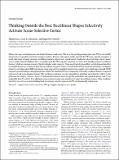| dc.contributor.author | Echavarria, Cesar | |
| dc.contributor.author | Nasr, Shahin | |
| dc.contributor.author | Tootell, Roger B. H. | |
| dc.date.accessioned | 2014-12-01T16:17:12Z | |
| dc.date.available | 2014-12-01T16:17:12Z | |
| dc.date.issued | 2014-05 | |
| dc.date.submitted | 2014-02 | |
| dc.identifier.issn | 0270-6474 | |
| dc.identifier.issn | 1529-2401 | |
| dc.identifier.uri | http://hdl.handle.net/1721.1/91956 | |
| dc.description.abstract | Fifteen years ago, an intriguing area was found in human visual cortex. This area (the parahippocampal place area [PPA]) was initially interpreted as responding selectively to images of places. However, subsequent studies reported that PPA also responds strongly to a much wider range of image categories, including inanimate objects, tools, spatial context, landmarks, objectively large objects, indoor scenes, and/or isolated buildings. Here, we hypothesized that PPA responds selectively to a lower-level stimulus property (rectilinear features), which are common to many of the above higher-order categories. Using a novel wavelet image filter, we first demonstrated that rectangular features are common in these diverse stimulus categories. Then we tested whether PPA is selectively activated by rectangular features in six independent fMRI experiments using progressively simplified stimuli, from complex real-world images, through 3D/2D computer-generated shapes, through simple line stimuli. We found that PPA was consistently activated by rectilinear features, compared with curved and nonrectangular features. This rectilinear preference was (1) comparable in amplitude and selectivity, relative to the preference for category (scenes vs faces), (2) independent of known biases for specific orientations and spatial frequency, and (3) not predictable from V1 activity. Two additional scene-responsive areas were sensitive to a subset of rectilinear features. Thus, rectilinear selectivity may serve as a crucial building block for category-selective responses in PPA and functionally related areas. | en_US |
| dc.description.sponsorship | National Institutes of Health (U.S.) (Grant R01 MH67529) | en_US |
| dc.description.sponsorship | National Institutes of Health (U.S.) (Grant R01 EY017081) | en_US |
| dc.description.sponsorship | Athinoula A. Martinos Center for Biomedical Imaging | en_US |
| dc.description.sponsorship | National Center for Research Resources (U.S.) | en_US |
| dc.description.sponsorship | Mental Illness and Neuroscience Discovery (MIND) Institute | en_US |
| dc.language.iso | en_US | |
| dc.publisher | Society for Neuroscience | en_US |
| dc.relation.isversionof | http://dx.doi.org/10.1523/jneurosci.4802-13.2014 | en_US |
| dc.rights | Article is made available in accordance with the publisher's policy and may be subject to US copyright law. Please refer to the publisher's site for terms of use. | en_US |
| dc.source | Society for Neuroscience | en_US |
| dc.title | Thinking Outside the Box: Rectilinear Shapes Selectively Activate Scene-Selective Cortex | en_US |
| dc.type | Article | en_US |
| dc.identifier.citation | Nasr, S., C. E. Echavarria, and R. B. H. Tootell. “Thinking Outside the Box: Rectilinear Shapes Selectively Activate Scene-Selective Cortex.” Journal of Neuroscience 34, no. 20 (May 14, 2014): 6721–6735. | en_US |
| dc.contributor.department | Harvard University--MIT Division of Health Sciences and Technology | en_US |
| dc.contributor.mitauthor | Echavarria, Cesar | en_US |
| dc.contributor.mitauthor | Tootell, Roger B. H. | en_US |
| dc.relation.journal | Journal of Neuroscience | en_US |
| dc.eprint.version | Final published version | en_US |
| dc.type.uri | http://purl.org/eprint/type/JournalArticle | en_US |
| eprint.status | http://purl.org/eprint/status/PeerReviewed | en_US |
| dspace.orderedauthors | Nasr, Shahin; Echavarria, Cesar E.; Tootell, Roger B. H. | en_US |
| mit.license | PUBLISHER_POLICY | en_US |
| mit.metadata.status | Complete | |
